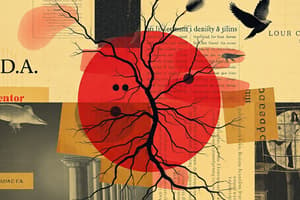Podcast
Questions and Answers
Which type of receptor is associated with the sense of deep pressure and vibration?
Which type of receptor is associated with the sense of deep pressure and vibration?
- Lamellar corpuscles (correct)
- Muscle spindles
- Bulbous corpuscles
- Meissner capsules
Where are hair receptors typically located?
Where are hair receptors typically located?
- Within the brain
- In the muscles
- Under the skin
- Around hair follicles (correct)
What type of receptors detect nociceptive pain?
What type of receptors detect nociceptive pain?
- Nociceptors (correct)
- Bulbous corpuscles
- Muscle spindles
- Meissner capsules
Which pathway does information from receptors traveling to the cerebral cortex mostly use?
Which pathway does information from receptors traveling to the cerebral cortex mostly use?
What type of pain is harder to locate due to being associated with internal cavities?
What type of pain is harder to locate due to being associated with internal cavities?
Which encapsulated nerve ending is associated with heavy continuous touch, pressure, and joint movements?
Which encapsulated nerve ending is associated with heavy continuous touch, pressure, and joint movements?
Where are muscle spindles primarily found?
Where are muscle spindles primarily found?
What type of pain is typically associated with arthritis, bone breaks, and sprains?
What type of pain is typically associated with arthritis, bone breaks, and sprains?
Which receptors are responsible for proprioception?
Which receptors are responsible for proprioception?
Where does the information from tendon organ receptors travel before reaching the cerebral cortex?
Where does the information from tendon organ receptors travel before reaching the cerebral cortex?
Which type of nerve fiber is responsible for immediate and sharp nerve pain?
Which type of nerve fiber is responsible for immediate and sharp nerve pain?
Which part of the brain is responsible for our emotional response to pain, such as crying and intense pain causing vomiting?
Which part of the brain is responsible for our emotional response to pain, such as crying and intense pain causing vomiting?
What is the main function of the spinothalamic tract in the spinal cord?
What is the main function of the spinothalamic tract in the spinal cord?
Which of the following is NOT one of the primary tastes detected by taste buds?
Which of the following is NOT one of the primary tastes detected by taste buds?
When experiencing referred pain, where does the pain perception often seem to originate from?
When experiencing referred pain, where does the pain perception often seem to originate from?
Which neurotransmitters act to block pain perception as part of the analgesic mechanism?
Which neurotransmitters act to block pain perception as part of the analgesic mechanism?
Which cranial nerve is primarily associated with transmitting signals related to taste to the brain?
Which cranial nerve is primarily associated with transmitting signals related to taste to the brain?
Pain originating from bones, muscles, and joints is classified as which type of pain?
Pain originating from bones, muscles, and joints is classified as which type of pain?
Flashcards are hidden until you start studying
Study Notes
Receptors and Pain
- Mechanoreceptors are associated with the sense of deep pressure and vibration.
- Hair receptors are typically located in the skin and detect light touch and vibrations.
Nociceptors and Pain
- Nociceptors are the type of receptors that detect nociceptive pain.
- Visceral pain, which is harder to locate, is associated with internal cavities.
Pathways and Processing
- Information from receptors travels to the cerebral cortex mostly through the spinothalamic tract.
- The anterior and lateral spinothalamic tracts are responsible for transmitting pain information.
Muscle and Joint Receptors
- Pacinian corpuscles are encapsulated nerve endings associated with heavy continuous touch, pressure, and joint movements.
- Muscle spindles are primarily found in skeletal muscles and detect muscle length and velocity.
Types of Pain
- Somatic pain is typically associated with arthritis, bone breaks, and sprains.
- Muscle and joint pain is classified as somatic pain.
Proprioception and Receptors
- Mechanoreceptors are responsible for proprioception, which is the sense of body position and movement.
Nerve Fibers and Processing
- Aδ nerve fibers are responsible for immediate and sharp pain.
- Information from tendon organ receptors travels to the cerebellum before reaching the cerebral cortex.
Emotional Response to Pain
- The insula is the part of the brain responsible for our emotional response to pain, such as crying and intense pain causing vomiting.
Neurotransmitters and Analgesia
- Endorphins and enkephalins are neurotransmitters that act to block pain perception as part of the analgesic mechanism.
Taste and Cranial Nerves
- The chorda tympani nerve (cranial nerve VII) is primarily associated with transmitting signals related to taste to the brain.
- Umami is one of the primary tastes detected by taste buds.
Pain Localization
- When experiencing referred pain, the pain perception often seems to originate from a location other than the actual source of the pain.
Pain Classification
- Pain originating from bones, muscles, and joints is classified as somatic pain.
Studying That Suits You
Use AI to generate personalized quizzes and flashcards to suit your learning preferences.




